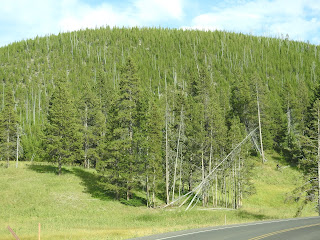Several of the t-loggers have told me that they can’t
post on the blog. Since I “own” the
blog, it is not possible for me to duplicate the problems. If any of you have instructions that can
help, please write it in the “Comments” block below. Second, I wrote that the Warden was “mortally
wounded but survived.” OK, OK, I get
it. You can’t survive being “mortally
wounded.” His throat was cut and he
nearly bled to death but didn’t. How’s
that?
It is very windy, here, and it gets cold at night. The thermometer read 34F first thing this
morning, it warmed up to 74 during the day but it is much too windy to use the
bbq. Fortunately, Louie’s world famous
Montana pasties came to the rescue.
Louie creates chicken and beef pasties stuffed with meat and vegetables
and wrapped in a flaky buttery crust. The
freezer is also stocked with six more and a supply of brown gravy to slather on
top! Perfectly tasty pasties!
 |
| Lunch with all the animals |
Louie’s bake shop is coincidentally (and conveniently)
located across the street from the Elk Ridge Brewing Company. Well, well, well. Here, with my name on it, I found a “Cow in
Heat Jalapeño Cream Ale” on
draught and hubness sipped a Kölsch. Just the ticket for a pleasant lunch
surrounded by elk and moose heads on the walls.
 |
| His Mooseness |
If Deer Lodge can claim no other fame, it has the corner
on museums. The Toy Museum was a worthy
stop where, on display, were memories of hours of childhood playtime. There were hundreds of dolls and buggies,
train sets clicking around through tunnels and around the bends over bridges,
and who can forget Tinkertoys, tops, tricycles and cap guns? If you have precious toys that you would like
preserved and protected, you can contact Melanie Sanchez, the Curator, at
406-846-3111. I’m sure she would like
your old hula hoop, clamp-on roller skates (with key), Lincoln logs, baton,
pogo stick and paint-by-numbers kits!
The Car Museum was just across the street, next door to
the territorial prison. Another
beautiful collection. Perfect vehicles,
some restored and some original, go back as far as 1886. There were many manufacturers early on before
the big three rose to the top, some names I don’t recognize at all. More than that, there were stories.
 |
| 1913 Cole |
 |
| There were a lot of these signs located on the trail across the country |
 |
| Map of the Yellowstone Trail |
So while some were racing, others were
getting into “automobile camping.” They
packed up their goods and duds into their vehicles and headed for the
hills. And the plains. On
the subject of “connecting the dots,” one of the places where these early
adventurers chose to camp was an empty piece of land in Deer Lodge, MT. This land is now the KOA where we have been
parked for 3 days. There is an old brick
building adjacent to the campground and I wondered about it. Cass, the KOA proprietor, told me that it was
the campers’ “pavilion” back then, where socials and other events took
place. Since that time, the government
has claimed rights to the building and they store road maintenance equipment
and other machinery in this pretty building.
 |
| "Automobile camping" in 1925 on the current KOA campground |
 |
| Rob, Noobee and the Jeepster on the 2019 version of the "automobile campground" |
 |
| City Pavilion next to the KOA campground |
 |
| 1910 Model T Turnabout |
 |
| 1916 Dodge Brothers Touring Car |
 |
| Some of you have probably been pursued by one of these? 1977 Plymouth Gran Fury |
 |
| 1965 Pontiac GTO |
 |
| Remember these? |
 |
| And these? |
There were beautiful late-model vehicles in the museum as
well but the very old-timers captured our fancy most. After many hours on our feet, time to head
for the ranch, a cold toonie, a hot pasty and a good night’s sleep so we’ll be
ready for our next adventure: Coeur
d’Alene, Idaho. Rob got us a place at
Blackwell RV Resort, one of my fave parks.
Tonight, we’ll celebrate my 852 months on the planet at Cedars, a floating
restaurant! Yay!
PS-If we had launched this trip in the clockwise
direction, my original idea, we’d be bracing ourselves for Hurricane Dorian
right now. Timing is everything and
wisdom is not optional!












































